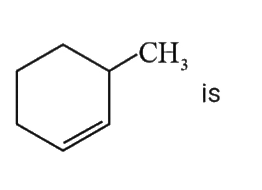The major product of acid catalysed dehydration of 2-methylcyclohexanol and butan-1-ol are respectively
1-methylcyclohexene and but-1-ene
2-methylcyclohexene and but-2-ene
2-methylcyclohexene and butane
1-methylcyclohexene and but-2-ene.
The correct Answer is:A
To solve the question regarding the major products of acid-catalyzed dehydration of 2-methylcyclohexanol and butan-1-ol, we will follow these steps:
Step 1: Identify the Structure of 2-Methylcyclohexanol
2-Methylcyclohexanol is a secondary alcohol with the hydroxyl (-OH) group attached to the second carbon of a cyclohexane ring. The structure can be represented as follows:
CH3∣∣CH2−CHCH2CH∣∣CH2−CH
Step 2: Mechanism of Dehydration
The dehydration of alcohols typically occurs via an E1 mechanism when an acid is present. In this case, 2-methylcyclohexanol will lose a water molecule (H2O) to form a carbocation.
Step 3: Formation of Carbocation
Since 2-methylcyclohexanol is a secondary alcohol, it will first form a secondary carbocation. However, this carbocation can rearrange to form a more stable tertiary carbocation through a hydride shift. The hydride shift involves the movement of a hydrogen atom from an adjacent carbon to the carbocation.
Step 4: Rearrangement to Tertiary Carbocation
The hydride shift results in the formation of a tertiary carbocation, which is more stable than the secondary carbocation. The structure of the tertiary carbocation can be represented as follows:
CH3∣∣CH2−CHCH2C+∣∣CH2−CH
Step 5: Elimination to Form Alkene
The tertiary carbocation will then lose a proton (H+) to form an alkene. The major product of this dehydration reaction will be 1-methylcyclohexene.
Step 6: Identify the Structure of Butan-1-ol
Butan-1-ol is a primary alcohol with the hydroxyl group at the first carbon. Its structure is:
CH3−CH2−CH2−CH2OH
Step 7: Mechanism of Dehydration for Butan-1-ol
The dehydration of butan-1-ol will also occur via an E1 mechanism. However, since it is a primary alcohol, it will initially form a primary carbocation, which is less stable. Therefore, it will undergo rearrangement to form a more stable carbocation.
Step 8: Formation of Carbocation
In the case of butan-1-ol, a hydride shift can occur, leading to the formation of a secondary carbocation.
Step 9: Elimination to Form Alkene
The secondary carbocation will then lose a proton to form the major product, which will be but-2-ene.
Final Answer
The major products of the acid-catalyzed dehydration of 2-methylcyclohexanol and butan-1-ol are:
1. 1-methylcyclohexene (from 2-methylcyclohexanol)
2. But-2-ene (from butan-1-ol)
---
2-Methylcyclohexanol is a secondary alcohol with the hydroxyl (-OH) group attached to the second carbon of a cyclohexane ring. The structure can be represented as follows:
The dehydration of alcohols typically occurs via an E1 mechanism when an acid is present. In this case, 2-methylcyclohexanol will lose a water molecule (H2O) to form a carbocation.
Since 2-methylcyclohexanol is a secondary alcohol, it will first form a secondary carbocation. However, this carbocation can rearrange to form a more stable tertiary carbocation through a hydride shift. The hydride shift involves the movement of a hydrogen atom from an adjacent carbon to the carbocation.
The hydride shift results in the formation of a tertiary carbocation, which is more stable than the secondary carbocation. The structure of the tertiary carbocation can be represented as follows:
The tertiary carbocation will then lose a proton (H+) to form an alkene. The major product of this dehydration reaction will be 1-methylcyclohexene.
Butan-1-ol is a primary alcohol with the hydroxyl group at the first carbon. Its structure is:
The dehydration of butan-1-ol will also occur via an E1 mechanism. However, since it is a primary alcohol, it will initially form a primary carbocation, which is less stable. Therefore, it will undergo rearrangement to form a more stable carbocation.
In the case of butan-1-ol, a hydride shift can occur, leading to the formation of a secondary carbocation.
The secondary carbocation will then lose a proton to form the major product, which will be but-2-ene.
The major products of the acid-catalyzed dehydration of 2-methylcyclohexanol and butan-1-ol are:
1. 1-methylcyclohexene (from 2-methylcyclohexanol)
2. But-2-ene (from butan-1-ol)
Topper's Solved these Questions
- BOOK - NCERT FINGERTIPSCHAPTER - ALCOHOLS,PHENOLS AND ETHERSEXERCISE - Some Commercially Important Alcohols4videos
ALCOHOLS,PHENOLS AND ETHERS
- BOOK - NCERT FINGERTIPSCHAPTER - ALCOHOLS,PHENOLS AND ETHERSEXERCISE - Ethers17videos
ALCOHOLS,PHENOLS AND ETHERS
- BOOK - NCERT FINGERTIPSCHAPTER - ALCOHOLS,PHENOLS AND ETHERSEXERCISE - Structures Of Functional Groups2videos
ALCOHOLS,PHENOLS AND ETHERS
- BOOK - NCERT FINGERTIPSCHAPTER - ALDEHYDES, KETONES AND CARBOXYLIC ACIDSEXERCISE - Assertion And Reason15videos
ALDEHYDES, KETONES AND CARBOXYLIC ACIDS
Similar Questions
Knowledge Check
- Question 1 - Select One
The product of acid catalysed hydration of 2-phenylpropene is
A3-phenyl-2-propanolB1-phenyl-2-propanolC2-phenyl-2-propanolD2-phenyl-1-propanol - Question 2 - Select One
The product of acid catalyzed hydration of 2−pheny1propene is
A3-phenyl-2-propanolB1-phenyl-2-propanolC2-phenyl-2-propanolD2-phenyl-1-propanol - Question 3 - Select One
Acid catalysed dehydration of 2-pentanol would give
A1-pentene as a major productBcis 2-pentene as a major productCtrans-2-pentene as a major productDcis- and trans - 2-pentene in equal amount.
Predict the major product of acid catalysed dehydration of
(i) 1-methylcyclohexanol and (ii) butan-1-olView SolutionThe major product formed by the acid catalysed hydration of
 View Solution
View SolutionPredict the major product of acid catalysed dehydration of :
(i) 1-Methylcyclohexanol (ii) Butan -1-olView SolutionThe major product obtained on acid-catalysed hydration of 2-phenylpropane is
View SolutionThe correct order of acid catalysed dehydration of alcohols is:
View Solution

